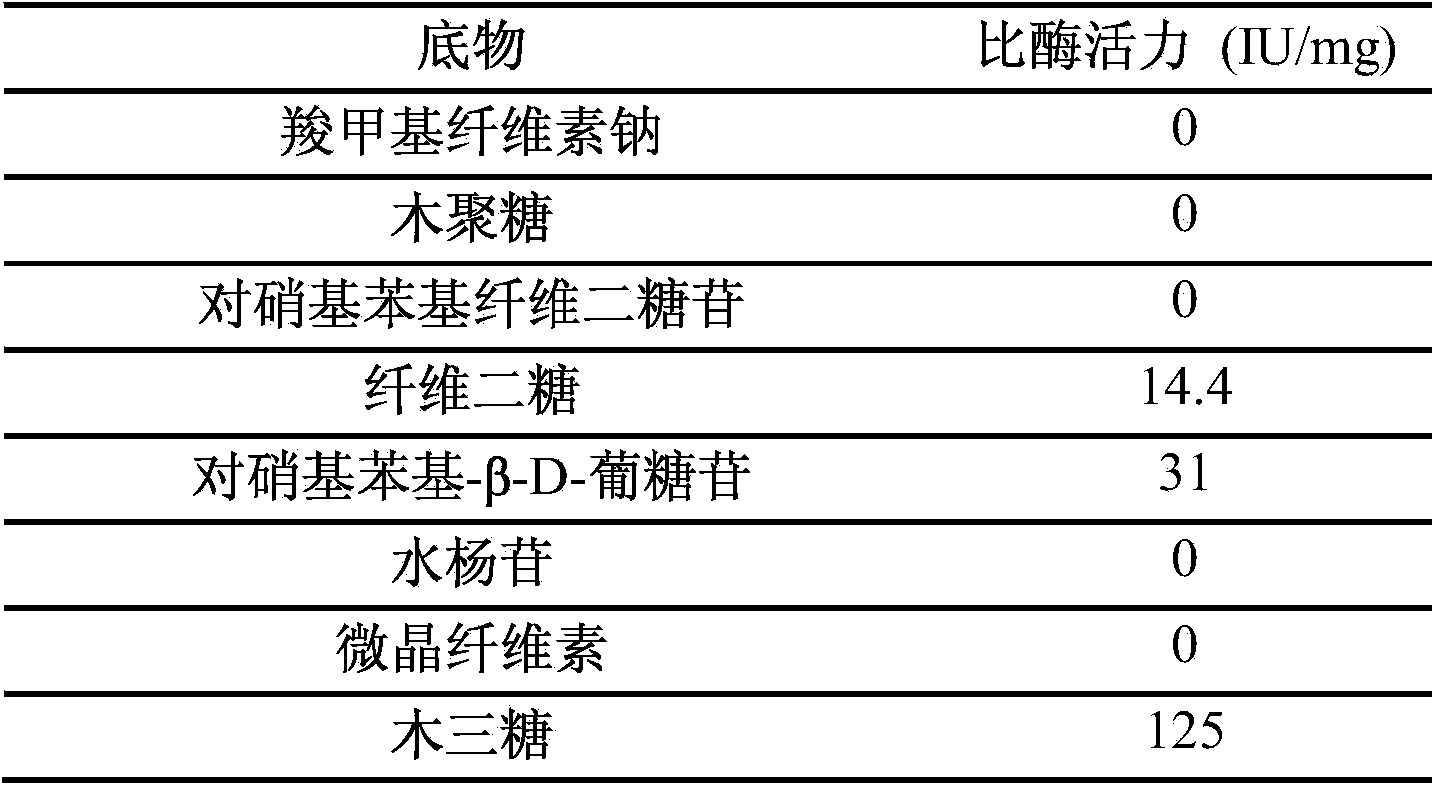Beta-glucosaccharase and application thereof
The technology of glucosidase and crude enzyme liquid is applied to beta-glucosidase and its application field, which can solve the problems of unclear enzymatic properties and biological functions, and achieve the effect of improving the efficiency of saccharification and hydrolysis
- Summary
- Abstract
- Description
- Claims
- Application Information
AI Technical Summary
Problems solved by technology
Method used
Image
Examples
Embodiment 1
[0020] Embodiment 1: The method steps of separating and purifying β-glucosidase are:
[0021] (1). Prepare the spore suspension of Penicillium juniper, and inoculate the spore suspension in a container with a fermentation broth, the fermentation broth contains a mass percentage of 2%-8% carbon source, 0.1%-5% Organic nitrogen source, and 0.0001%-10% inorganic salt, pH value is adjusted between 3.0-5.0. Place the container on a shaker for shaking culture;
[0022] (2). The fermented liquid is centrifuged at a high speed to remove impurities and keep the soluble protein part of the supernatant. Retain protein through 10kDa membrane, concentrate protein by ultrafiltration;
[0023] (3). Put the concentrated protein on a molecular sieve gel chromatography column Sephadex S-200 to collect the samples;
[0024] (4) The new type of β-glucosidase was identified by protein mass spectrometry MALDI-TOF;
[0025] (5). Using the glucoside pNPG as a substrate, the β-glucosidase enzyme a...
Embodiment 2
[0031] Embodiment 2: the research of the property of β-glucosidase
[0032] 1) Using conventional methods in the field to combine β-glucosidase with carboxymethylcellulose (CMC-Na), salicin (Salicin), PNPC, microcrystalline cellulose (Avicel), xylan (Xylan), PNPG, and cellobiose respectively carried out the enzyme activity test results as shown in Table 1: PpCel3E to carboxymethylcellulose sodium (CMC-Na), salicin (Salicin), PNPC, microcrystalline cellulose (Avicel), Xylan has no enzymatic activity. For PNPG, cellobiose has higher enzyme activities of 31.0IU / mg and 14.4IU / mg respectively. PpCel3E has the ability to hydrolyze cellooligosaccharides, and can decompose cellotriose into cellobiose and glucose, with an enzyme activity of up to 125IU / mg.
[0033]
[0034] Table 1
[0035] 2) Detection of the affinity between the novel β-glucosidase PpCel3E and the substrate:
[0036] With p-nitrophenyl-β-D-glucoside (PNPG) as substrate, PpCel3E K m The value is 0.0019mM, whic...
Embodiment 3
[0042] Example 3: Application of PpCel3E in inducing cellulase-producing bacteria to synthesize cellulase or hemicellulase.
[0043] With 40 g / L glucose as substrate, 100 μg PpCel3E was added, and reacted in a water-bath shaker at 50° C. for 72 h. After the reaction, the type and concentration of the product were analyzed using an Agilent ZORBAX Carbohydrate sugar analysis column. The detection conditions were acetonitrile as the mobile phase, the flow rate was 1.0 mL / min, and the detection temperature was 30°C. The detection standard selections are: sophorose and gentiobiose.
[0044] With xylotriose as the substrate, 100 μg PpCel3E was added, and reacted in a water-bath shaker at 50° C. for 72 hours. Aminex HPX-87H sugar analysis column was used to analyze the type and concentration of the product. The detection conditions were 5mM sulfuric acid as the mobile phase, the flow rate was 0.6mL / min, and the detection temperature was 60°C.
[0045]
[0046] table 3
[0047] ...
PUM
 Login to View More
Login to View More Abstract
Description
Claims
Application Information
 Login to View More
Login to View More - R&D
- Intellectual Property
- Life Sciences
- Materials
- Tech Scout
- Unparalleled Data Quality
- Higher Quality Content
- 60% Fewer Hallucinations
Browse by: Latest US Patents, China's latest patents, Technical Efficacy Thesaurus, Application Domain, Technology Topic, Popular Technical Reports.
© 2025 PatSnap. All rights reserved.Legal|Privacy policy|Modern Slavery Act Transparency Statement|Sitemap|About US| Contact US: help@patsnap.com



